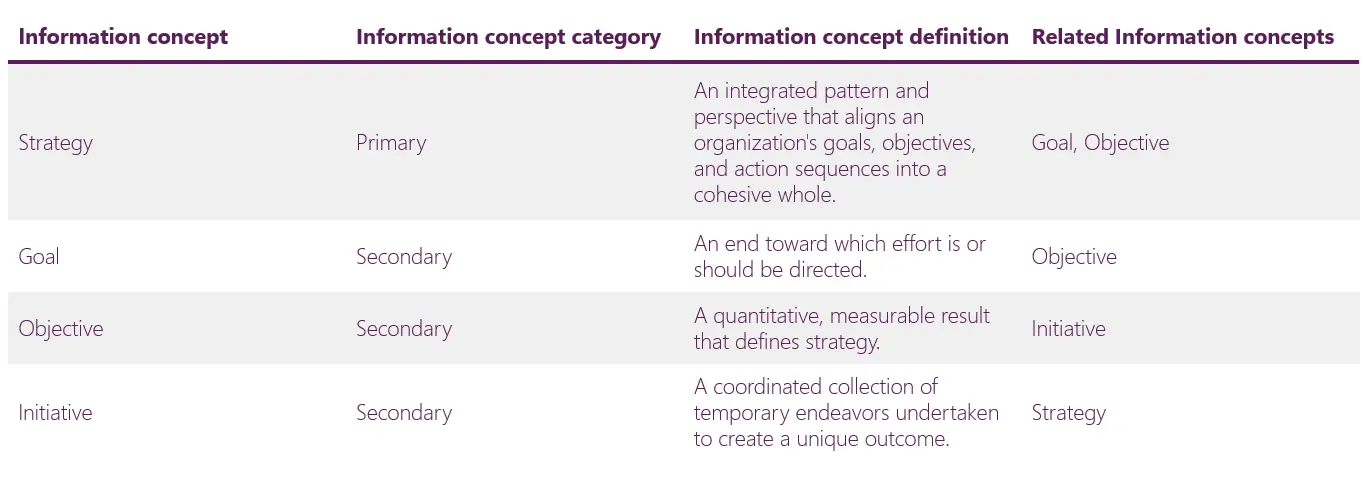The Information Map is a schematic representation of the set of information concepts and their interrelationships that are important to an organization. Information is considered an intangible, conceptual representation of things that exist in the real world. Information concepts form the basis of the architectural elements that are used to make these intangibles explicit. They are used to model a business, not an IT system.
Information concepts reflect the language spoken within the organization (the corporate vocabulary, such as customer, account or product). The great advantage of having an Information Map is the ability to communicate unambiguously within the organization and across departments, using a consistent and uniform language that is known within the organization.
A completed Information Map provides insight into the issues that are important to the organization and allows the architect to determine where this information will be used.
The Information Map of a business is most useful when cross-mapped to the capabilities, strategic plans and initiatives that require changes in how information is employed by the business1.
In addition to the definition shown, an information concept can also be related to business processes and applications.
Applying the method
Identifying the information concepts to be included in the Information Map begins with identifying the elements that are most important to the business. One way to get an overview of the existing information concepts is to listen to the nouns used when people talk about different topics within the organization. Every noun is potentially an information concept. By distilling the nouns from the conversations, it is possible to determine whether they represent an information item that the organization values.
Gathering information
Ask the following questions to identify key information concepts:
- What are the organization’s key deliverables?
- What products and services does the organization provide to customers?
- What types of information are used?
- Looking at key processes, what laws and regulations govern them?
- Do applicable laws and regulations require the creation of specific products and services?

Creating the map
A spreadsheet tool can be used initially to capture information concepts.
- Be sure to collect and record as much additional information as possible so that cross-mappings can be made later.
- When recording additional information, consider determining the category of the information concept and its relationship to other information concepts.
- Include a clear definition of the information concept.
- All information concepts should be registered in the repository along with the Information Map.
Including information
At a minimum, the following columns should be used when creating an Information Map.
- Information Concept. The Information Map names and contains all the information concepts that exist and are important in the organization. The information concept realizes a business object, where the business object defines the basic naming convention for the information concept.
- Information Concept Category. There are two categories of information concepts. A primary information concept realizes a business object that is not dependent on another business object. A secondary information concept realizes a business object that is dependent on another business object. For example, the information concept Strategy is a primary information concept. It exists on its own and does not depend on any other business object. Information concepts such as Goal, Objective, and Initiative are secondary information concepts because they depend on a business object (in this case, the Strategy business object).
- Information Concept Definition. The definition of an information concept is derived from the (business) object part of the capability definition and omits the action part of the definition. For example, if the capability is called Strategy Management, the business object would be called Strategy, which would also be the name for the information concept.
- Related Information Concepts. Relationships between information concepts mirror relationships between business objects. Related information concepts are a logical derivative of the primary information concept. For example, Goal and Objective are both direct derivatives of Strategy. Initiative, on the other hand, is an indirect derivative of Strategy and can exist without the presence of Strategy because it also has a relationship with, e.g., the Portfolio information concept. Therefore, for the primary information concept Strategy, the secondary information concepts Goal, Objective, and Initiative are listed in the Related Information Concepts column.
Graphical representation

To graphically represent an information concept in a model, the business object concept is used. There is currently no separate concept in the modeling language that is a direct translation of the information concept. The definition of a business object shows that this concept can contain information that is essential to an organization, making it a plausible concept to use.
Definition
Only occasionally, business objects represent actual instances of information produced and consumed by behavior elements such as business processes2.

Relations
The figure on the left shows the relationship between the primary information concept Strategy and the secondary concepts Goal, Objective, and Initiative. Among them, Goal, Objective, and Initiative are interrelated. The information concept Strategy has a compositional relationship with Goal and Objective because the secondary information concepts exist only because of the fact that Strategy exists. The aggregation relationship between Strategy and Initiative arises because Initiative can exist without the primary information concept Strategy. This is due to the fact that the secondary information concept Initiative does not depend on Strategy alone. It can also have a relationship with, for example, the information concept Portfolio (or in some cases also with the information concept Project).
More information
For additional information about creating an Information Map, please refer to Chapter 8, Section 8.2.1.3, of my book Getting Started with Enterprise Architecture.
Back to
- Business Architecture Guild®, Information Mapping, in A Guide to the Business Architecture Body of Knowledge®, 2022. ↩︎
- The Open Group, ArchiMate® 3.2 Specification. ’s-Hertogenbosch: Van Haren Publishing, 2023. ↩︎
